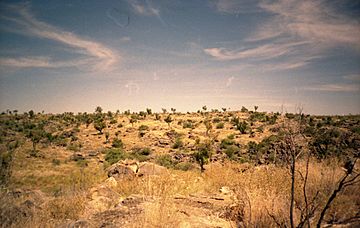Riversleigh World Heritage Area facts for kids
| UNESCO World Heritage Site | |
|---|---|
 |
|
| Location | Gregory, Queensland, Australia |
| Part of | Australian Fossil Mammal Sites (Riversleigh / Naracoorte) |
| Criteria | Natural: (viii), (ix) |
| Inscription | 1994 (18th Session) |
| Area | 10,029 ha (38.72 sq mi) |
The Riversleigh World Heritage Area is a very special place in Australia. It is famous for its amazing fossils. These fossils show us what life was like from about 28 million years ago until more recent times.
This area is found near the Gregory River in north-west Queensland. Long ago, this place was a wet rainforest. Over time, it became much drier. This happened as the huge landmass called Gondwana broke apart. The Australian continent then moved north.
The Riversleigh area is about 100 square kilometers (39 square miles). It holds the fossil remains of ancient mammals, birds, and reptiles. Many of these animals are only known from Riversleigh. Scientists call these ancient creatures the Riversleigh fauna.
What makes Riversleigh fossils so special? They are found in soft freshwater limestone. This limestone has not been squashed flat. This means the animal remains still have their original 3D shape. In most other fossil sites, bones are often crushed.
Many fossils are found in old limestone caves and cracks. These spots acted like natural traps for animals. Predators might have hunted there too. Sometimes, these places quickly got covered up and preserved the remains. This is why so many bat fossils are found here. Their droppings, called guano, even helped to preserve other fossils!
People first noticed fossils here in 1901. Serious studies began in 1976. In 1994, Riversleigh became a World Heritage Site. It shares this title with the Naracoorte Caves National Park in South Australia. Riversleigh is also part of the Boodjamulla National Park.
Contents
What Makes Riversleigh Fossils Unique?
The fossils at Riversleigh are found in limestone. This limestone formed in lime-rich freshwater pools and caves. Back then, the area was changing. It went from a thick rainforest to a drier grassland. Some of these fossils are 25 million years old!
The high amount of calcium carbonate in the rock helped keep the fossils in great shape. This collection of fossils shows how mammals changed over more than 20 million years. Scientists have found fossils in over 200 different spots here. This fossil record is very important. It helps us understand how species evolved and spread across the ancient continent of Gondwana.
Ancient Life at Riversleigh
Scientists have divided the Riversleigh fossils into four main time periods. They call these "faunal zones." Each zone shows different types of animals that lived there:
- Faunal Zone A: About 28.4 to 23 million years ago (Late Oligocene)
- Faunal Zone B: About 23 to 16 million years ago (Early Miocene)
- Faunal Zone C: About 16 to 11.6 million years ago (Middle Miocene)
- Faunal Zone D: About 11.6 to 5.3 million years ago (Late Miocene)
Riversleigh has the most bat fossil species in the world. Scientists have found 35 different kinds of ancient bats here. The cave deposits are especially rich in bat fossils.
Scientists also found the skull of a 15-million-year-old monotreme. This animal, called Obdurodon dicksoni, was an ancestor of today's platypuses and echidnas. It helps us learn how these unique Australian animals evolved.
Fossils of ancient thylacines have also been found. These are relatives of the recently extinct Tasmanian tiger. In 1993, scientists found skulls of a koala-like animal called Nimbadon. This marsupial lived about 15 million years ago and died out around 12 million years ago. Climate change might have caused it to lose its home.
A well-preserved skull of Nimbacinus dicksoni was also found. This was another ancient relative of the thylacine. Its skull helped scientists figure out how it hunted. Other fossils show how the koala changed as Australia's rainforests turned into drier eucalypt forests.
Ancient bird fossils have been found too. These include a bird called Kurrartapu johnnguyeni and other birds similar to modern ones. Some fossil insects and plants have also been discovered. All these ancient species found at Riversleigh are known as the Riversleigh fauna.
Who Studies Riversleigh?
Most of the scientific work at Riversleigh is done by palaeontologists. These are scientists who study fossils. Many of them are from the University of New South Wales.
One famous palaeontologist, Mike Archer, has been working at Riversleigh since 1983. He and his team found a clever way to get the fossils out of the rock. They use a weak acid called acetic acid. This acid helps to gently remove the rock without harming the delicate fossils.
See also
 In Spanish: Riversleigh para niños
In Spanish: Riversleigh para niños


